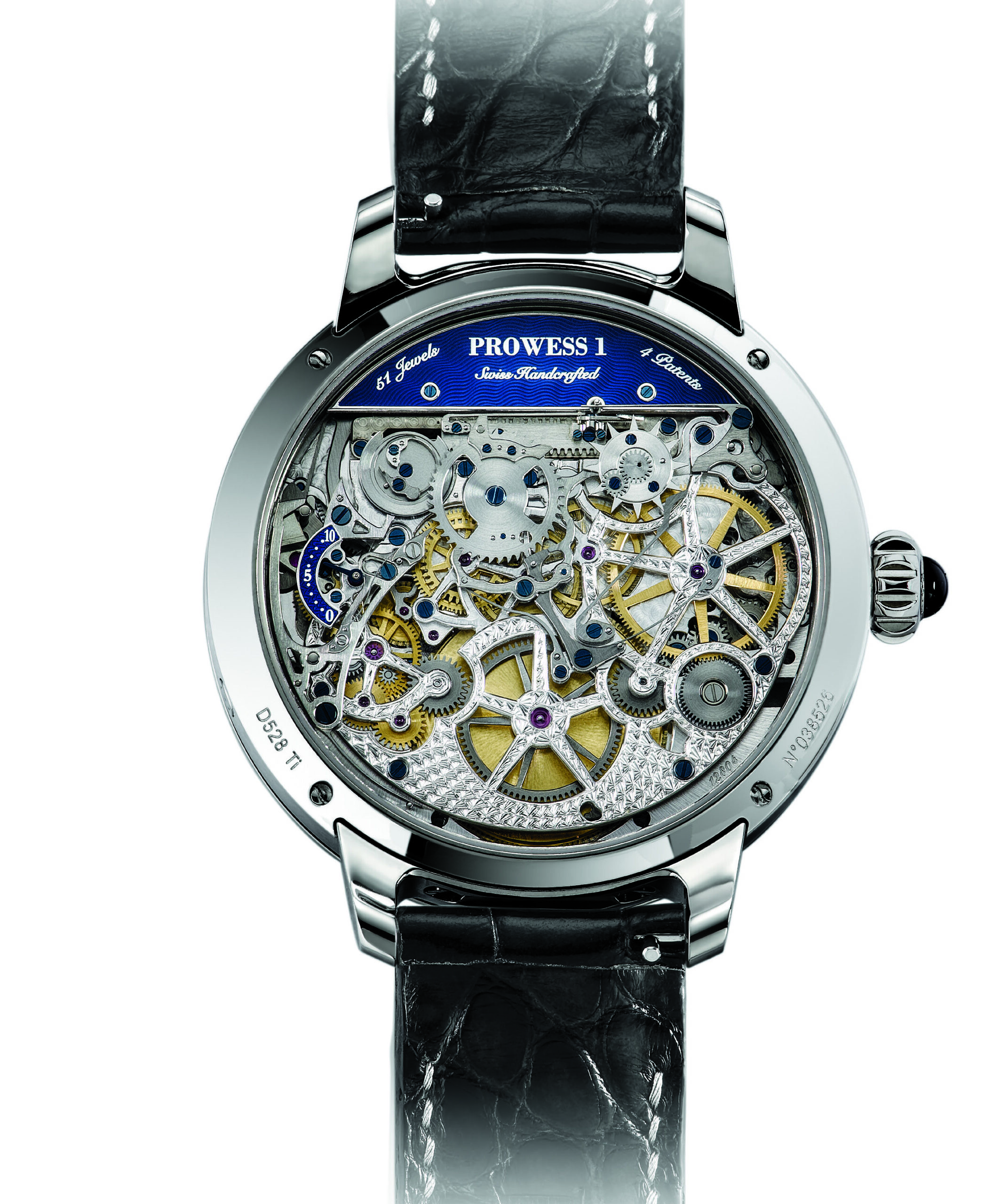ก่อนศตวรรษที่ 19 เมื่อเรือกลไฟและรถไฟช่วยขยายขีดความสามารถในการเดินทางไกล บนข้อมือของผู้คนแทบไม่มีใครใส่ใจกับการติดตามเขตเวลา แต่ในช่วงทศวรรษ 1930 เมื่อนาฬิกาบอกเวลาโลก (world-time complication) วางจำหน่าย กลายเป็นมาตรฐานใหม่สำหรับนาฬิกาของนักเดินทาง ทันใดนั้น เพียงแค่เหลือบมอง เราก็สามารถดูเวลาทั้งนาทีและชั่วโมงในทุกเขตเวลาพร้อมกัน
ปัญหาเดียวคือ ประชาคมโลกไม่สามารถตกลงกันได้ในระบบเขตเวลาสากลเพียงระบบเดียว แม้กระทั่งทุกวันนี้ก็ยังเป็นเช่นนั้น ในสหรัฐอเมริกา มีบางรัฐที่ไม่สนใจเวลามาตรฐานฤดูร้อน (DST) เลย และบางประเทศใกล้เส้นศูนย์สูตรก็ไม่จำเป็นต้องใช้เช่นกัน ยังมีการพูดคุยกันอย่างต่อเนื่องเกี่ยวกับการยกเลิกระบบนี้โดยสิ้นเชิง
สำหรับช่างนาฬิกาแล้ว ฉันทามติที่ไม่มีที่สิ้นสุดนี้ ทำให้การพัฒนาฟังค์ชั่นบอกเวลาโลกที่สามารถคำนวณเวลา DST กลายเป็นเรื่องยุ่งยาก แต่ Bovet ได้สร้างสิ่งประดิษฐ์ที่ก้าวล้ำ ซึ่งจะเปลี่ยนแปลงทุกอย่าง: ขอแนะนำ Récital 28 Prowess 1 นาฬิกาข้อมือที่ใช้ระบบกลไกทั้งหมดในการแก้ปัญหานี้ นาฬิกานี้บรรจุอยู่ในตัวเรือนขนาด 46.3 มม. ผลงานด้านวิศวกรรมระดับไมโครชิ้นชิ้นนี้ ช่วยให้ผู้สวมใส่สามารถดูเวลาได้ไม่เพียงแค่ 24 เขตเวลาทั่วโลก แต่ยังรวมถึงเวลามาตรฐานสากล (UTC) เวลาฤดูร้อนอเมริกา (AST) เวลาฤดูร้อนยุโรปและอเมริกา (EAS) และเวลามาตรฐานยุโรป (EWT) ด้วย นอกจากระบบที่ซับซ้อนนี้อีก Bovet ยังตัดสินใจที่จะรวมเข้ากับทั้ง Tourbillon และ ปฏิทินถาวร
ภายในหน้าปัดย่อยขนาดใหญ่ทางด้านล่างของหน้าปัดหลักอันกว้าง ระบบลูกกลิ้งจะแสดงชื่อเมือง 24 แห่ง ผ่านการตั้งค่าปุ่มที่อยู่ภายในเม็ดมะยม ระบบนี้สามารถตั้งค่าเป็น UTC, AST, EAS หรือ EWT ช่วยให้ผู้สวมใส่สามารถดูเวลาที่แตกต่างกันทั่วโลกตามเวลาฤดูร้อน ร่วมกับหน้าปัดกลิ้งทั้งสี่แบบ แสดงวัน วันที่ เดือน และปีอธิกสุรทินด้วยตัวเลขสีขาวบนพื้นหลังสีดำ ซึ่งทั้งหมดจะรีเซ็ตโดยอัตโนมัติเมื่อสิ้นเดือน ในขณะเดียวกัน จะมี Tourbillon อยู่ที่ตำแหน่ง 12 นาฬิกา ส่วนประกอบที่มีน้ำหนักเบาพิเศษนี้มีน้ำหนักเพียง 0.35 กรัม แม้ว่าจะอยู่ภายในกรงที่ประกอบด้วยชิ้นส่วนแยก 62 ชิ้น ผลลัพธ์ที่ได้คือ เครื่องจักรที่คล้ายกับคอมพิวเตอร์รุ่นแรกมากกว่านาฬิกาข้อมือ
แน่นอน ในด้านความสวยงาม Prowess 1 ถือเป็นงานศิลปะ หน้าปัด aventurine ด้านใน, ช่องแสดงวันที่, และ Tourbillon ที่ลอยอยู่นั้นล้อมรอบด้วยกลไกที่มองเห็นได้ ซึ่งเป็นเพียงส่วนหนึ่งของ 744 ชิ้นส่วนที่ประกอบเป็นกลไกภายในรุ่น R28-70-00X ที่มีสำรองพลังงาน 10 วัน เมื่อพลิกนาฬิกากลับด้าน จะเผยให้เห็นการตกแต่งอันน่าทึ่งของนาฬิกาชั้นสูง ไม่ว่าจะเป็นลาย Côtes de Genève, perlage และเทคนิคการตกแต่งด้วยมืออื่นๆ ที่สวยงาม ดังนั้นจึงไม่น่าแปลกใจที่นาฬิกาเรือนนี้ต้องใช้เวลานานในการผลิตมากๆ ด้วยเหตุนี้ Prowess 1 จึงผลิตเพียงแค่ปีละ 8 เรือนเท่านั้น โดยมีให้เลือกทั้งตัวเรือนทองคำ 18K ทอง Platinum 950 และไทเทเนียมเกรด 5
Bovet ไม่ใช่แบรนด์หน้าใหม่ในวงการนาฬิกาสุดซับซ้อน แคตตาล็อกของพวกเขามีนาฬิกาบอกเวลาสอง, สาม และหลายเขตเวลา รวมถึงรุ่น Orbus Mundi ที่สามารถตั้งค่าได้ทั้งหมดผ่านเม็ดมะยม Prowess 1 สืบทอดตำนานนั้น ต่อเนื่องจากรางวัล GPHG Mechanical Exception ที่ Bovet ได้รับในปี 2020 สำหรับนาฬิกา Récital 26 Brainstorm Chapter Two Prowess 1 ดูเหมือนว่าจะได้รับรางวัลนี้อีกครั้งในปี 2024
การแสวงหาคำตอบทางกลไกที่ซับซ้อนสำหรับปัญหาที่มีวิธีแก้ไขแบบดิจิทัลง่ายๆ ต้องอาศัยความเชื่อและความชื่นชมในงานฝีมือ แต่ในทางกลับกัน เมื่อเราเต็มใจที่จะเรียนรู้จักกลไกเหล่านี้ การค้นพบเช่นนี้ก็สามารถส่องประกายแห่งความสุขแบบอนาล็อก ให้กับโลกดิจิทัลที่มีประสิทธิภาพสูงแต่ไร้ซึ่งความรู้สึก
บทความโดย Oren Hartov

Before the 19th century, when the steamship and the railroad greatly expanded the capacity for long-distance transit, little attention was paid to tracking time zones on the wrist. But in the 1930s, when the world-time complication came to market, a new standard was set for traveler’s watches—suddenly, with just a glance, one could see the hour and minute in all time zones simultaneously.
The only problem? The international community couldn’t quite agree on a single, universal time-zone system. It still can’t. In the U.S., a handful of states completely ignore daylight saving time (DST), and certain countries near the equator similarly have no use for it; there’s persistent talk about jettisoning the system altogether.
For watchmakers, this lack of consensus makes developing a world-time complication that can account for DST a wildly troublesome proposition. But a breakthrough by Bovet promises to change all that: Meet the Récital 28 Prowess 1, a wristwatch whose operation—entirely mechanical— solves the horological head-scratcher. Housed in a 46.3 mm case, this remarkable feat of micro-engineering allows the wearer to account for not only 24 global time zones but also for Coordinated Universal Time (UTC), American summertime (AST), European and American summertime (EAS), and European wintertime (EWT). And then, as if this system didn’t present enough of a development challenge, Bovet decided to combine it with both a flying tourbillon and a perpetual-calendar complication.
Within a large subdial toward the bottom of the sizable dial, a system of rollers displays 24 city names via a button set within the crown; this system can be set to UTC, AST, EAS, or EWT, allowing the wearer to account for the differences of time around the world owing to daylight saving. In concert, four rolling displays show the day, date, month, and leap year in white text set against a black background, all of which reset automatically at the end of each month. Meanwhile, a flying tourbillon is positioned at 12 o’clock; the featherweight component weighs just 0.35 grams despite being housed in a cage composed of 62 separate parts. The result is a machine more akin to a rudimentary computer than a wristwatch.
Except, of course, aesthetically, by which measure the Prowess 1 could be considered a work of art. The inner aventurine dial, calendar displays, and flying tourbillon are surrounded by visible movement components, which constitute just a handful of the 744 parts that make up the in-house caliber R28-70-00X with its 10 days of power reserve. Flip the watch over, and a captivating display of haute horlogerie is revealed: Côtes de Genève, perlage, and other artisanal techniques provide a visual feast. As one would expect, the timepiece is exceedingly time-consuming to produce; as such, the Prowess 1 will be limited to just eight pieces per year offered in 18-karat red gold, 950 platinum, and grade 5 titanium.
Bovet, of course, is no stranger to the development of such complicated wonders: Its catalog includes dual-time, triple-time-zone, and world timers such as the Orbus Mundi, set entirely via the crown. The Prowess 1 builds upon that legacy. Following the brand’s GPHG Mechanical Exception prize win in 2020 for its Récital 26 Brainstorm Chapter Two, the Prowess 1 seems like a shoo-in for a repeat in 2024.
The pursuit of complicated mechanical answers to problems with easy digital solutions requires a certain suspension of disbelief. Then again, when one is willing to engage with this gear-and-pinion mindset, such discoveries have the ability to cast a joyful sort of analog light on an increasingly cold, efficient electronic world.
The article by Oren Hartov










